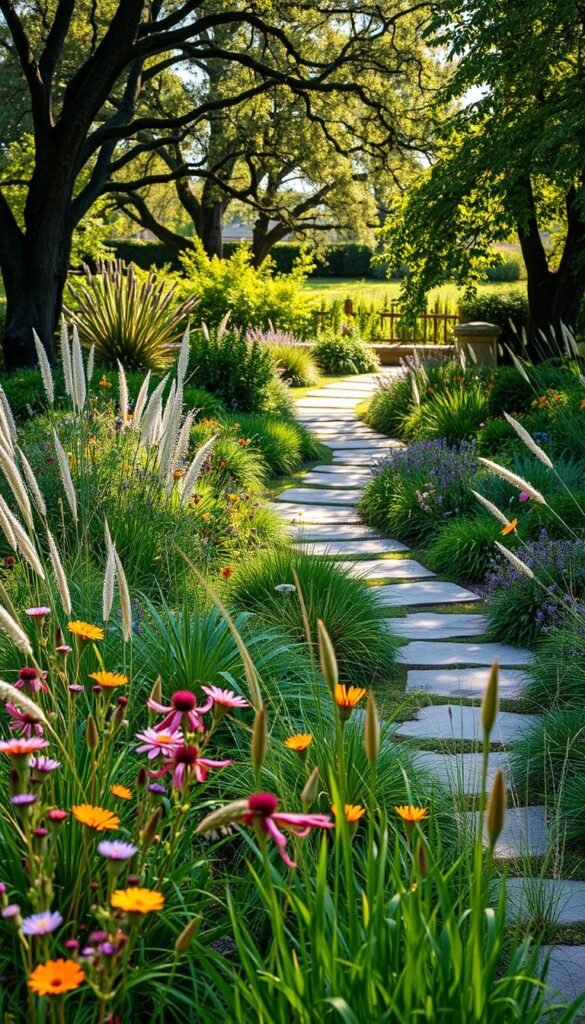Imagine transforming your backyard into a vibrant habitat that thrives with minimal effort. Local flora offers a powerful way to build landscapes that naturally align with your region’s climate and wildlife. These species have evolved over centuries to flourish in your area’s soil, rainfall patterns, and temperature swings—making them resilient allies in your gardening journey.
By focusing on indigenous varieties, you’ll reduce water use and create a self-sustaining ecosystem. Birds, butterflies, and pollinators like bees will flock to these familiar food sources, turning your space into a lively sanctuary. Best of all? Once established, these landscapes demand far less upkeep than traditional lawns or exotic plantings.
This approach isn’t just about aesthetics—it’s a practical step toward environmental stewardship. Communities across the U.S. are embracing this movement, recognizing how regionally adapted plants combat soil erosion and support biodiversity. Whether you’re in arid Arizona or rainy Washington, your choices directly impact local ecosystems.
Ready to explore how these natural wonders can redefine your outdoor space? Let’s dive into the principles that make this method both beautiful and ecologically vital.
Understanding the Role of Native Plants in Your Landscape
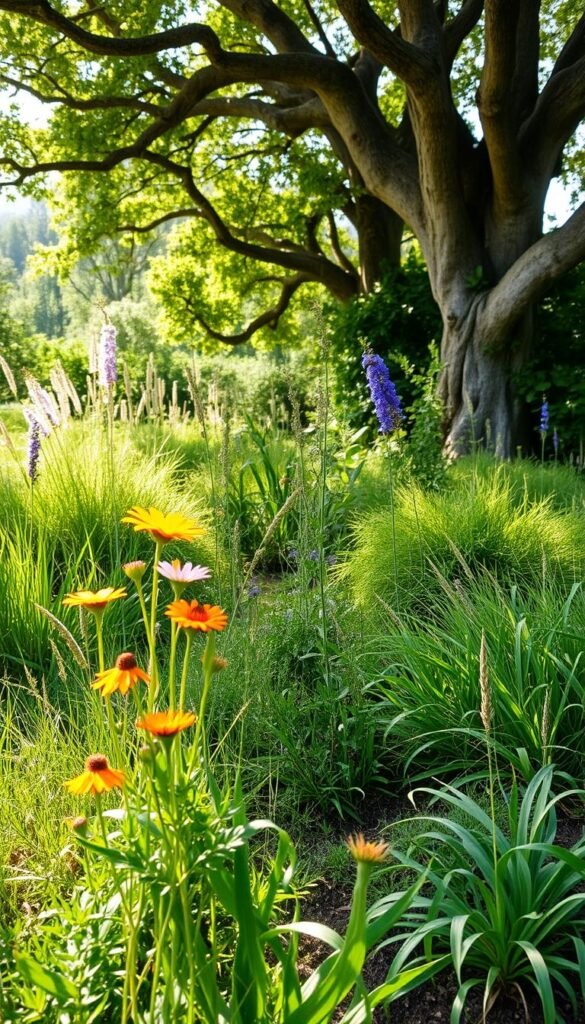
Nature’s blueprint for thriving gardens lies in species that evolved alongside your region’s unique conditions. These native plants developed survival strategies over millennia, making them perfect partners for low-effort, high-impact gardening.
Built for Your Backyard’s Conditions
Indigenous species grow deep roots that tap into groundwater during droughts. Their leaves often have waxy coatings or fuzzy textures to handle temperature extremes. This means they thrive in your local climate without constant watering or soil additives.
For example, prairie grasses like switchgrass stabilize erosion-prone areas naturally. Their extensive root systems improve soil structure better than most non-native groundcovers. You’ll spend less time battling plant stress and more enjoying your vibrant landscape.
Nature’s Support System
Local ecosystems depend on specific plant species. Monarch butterflies need milkweed, while chickadees seek native berry shrubs for nesting. By choosing regionally adapted varieties, you create a buffet for local wildlife – from earthworms to foxes.
This approach aligns with permaculture gardening design principles, emphasizing harmony with natural systems. Your garden becomes a living network where every element supports biodiversity, from pollinators to beneficial fungi in the soil.
As seasons change, these plants maintain balance in your ecosystem. They drop leaves that become natural mulch and attract insects that control pests. It’s gardening that works with nature – not against it.
Benefits of Native Plant Landscaping for Sustainable Gardening
What if your garden could save water while buzzing with life? Landscaping with regional species offers surprising advantages that go beyond basic beauty. These native plants work smarter, not harder, to create resilient outdoor spaces.
Less Work, More Natural Resources
Deep-rooted varieties drink from groundwater reserves, slashing irrigation needs by 50-80% compared to thirsty lawns. Once established, they thrive on rainfall alone in most regions. You’ll also skip weekly chores like fertilizing – their natural adaptations prevent pest invasions and soil depletion.
| Feature | Traditional Landscaping | Native Plant Design |
|---|---|---|
| Water Needs | High | Low |
| Weekly Upkeep | 3-5 hours | 1 hour |
| Chemical Use | Frequent | Rare |
Nature’s Pest Control Team Moves In
Tube-shaped blossoms feed specific pollinators like hummingbirds, while flat clusters attract butterflies. This diversity brings beneficial allies – ladybugs devour aphids, and ground beetles target slugs. Your plants get protection without toxic sprays.
These ecological partnerships boost food crops too. Fruit trees near native flowering species see up to 30% higher yields from increased pollination. It’s a win for your table and local ecosystems.
Best part? Your landscape grows lovelier each year as roots strengthen and wildlife returns. You’re not just planting greenery – you’re rebuilding natural networks that sustain themselves.
Design Principles for an Eco-Friendly Garden Layout
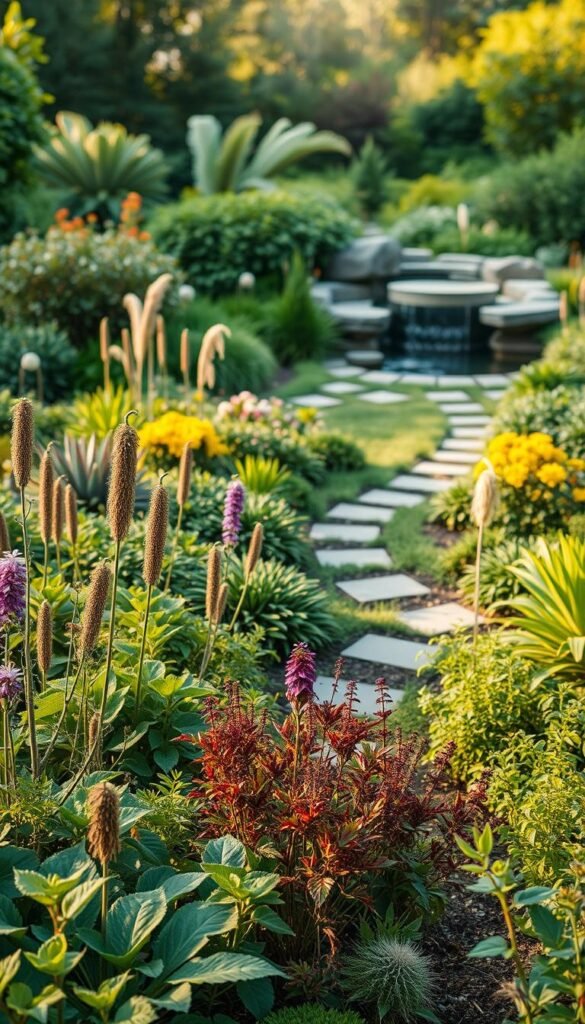
Blending beauty and ecology requires smart layout choices from the ground up. A successful design balances visual appeal with habitat value, creating spaces where every element serves multiple purposes. Let’s explore how to craft landscapes that delight the eye while nurturing local ecosystems.
Achieving Balance and Unity in Your Garden
Start by establishing a structural foundation using native grasses. Landscape legend Piet Oudolf champions this “matrix” approach, where grasses act as a living canvas. Their flowing forms unify diverse plant groupings while mimicking natural meadows.
Follow these key strategies:
- Mix heights and textures – tall prairie flowers behind mounding shrubs
- Repeat color patterns seasonally (spring violets → summer yellows → fall oranges)
- Use curved pathways to guide exploration without disrupting habitats
For smooth transitions between garden areas, layer plants with staggered bloom times. Cluster moisture-loving species near rain gardens and drought-tolerant varieties on slopes. This creates visual flow while supporting different microhabitats.
Want to simplify your planning? Many gardeners find success using modular planting zones based on sunlight and soil conditions. This approach maintains design cohesion while accommodating nature’s variability.
Remember: True harmony emerges when your layout respects the land’s natural contours. Work with existing slopes and drainage patterns rather than fighting them. Your reward? A living masterpiece that grows more captivating – and ecologically robust – each year.
Using Native Plants to Create an Eco-Friendly Garden Design
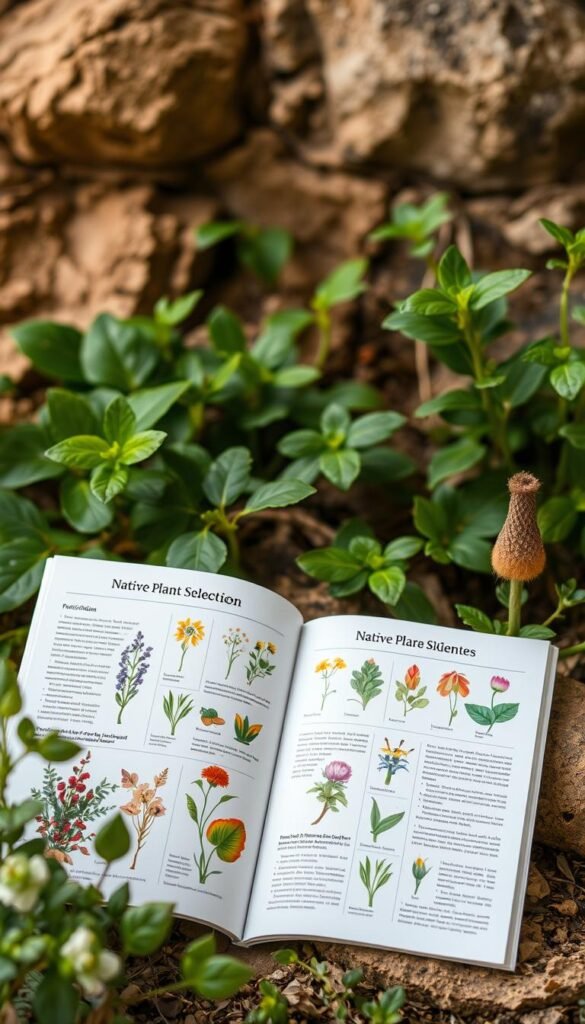
Choosing plants that naturally belong in your region sets the stage for a thriving outdoor space. Start by matching species to your yard’s unique conditions – it’s like finding puzzle pieces that click perfectly into place.
Selecting the Right Native Species for Your Area
Your soil’s texture and pH levels determine which species will succeed. Sandy soils suit drought-tolerant varieties, while clay-heavy earth needs plants with strong root systems. Free tools from GrowNative.org help identify options tailored to your ZIP code.
| Selection Factor | Traditional Approach | Native Strategy |
|---|---|---|
| Water Needs | High (sprinklers) | Rainfall-only |
| Soil Prep | Amendments required | Natural adaptation |
| Wildlife Value | Low | High |
Planning Your Garden with Ecosystem Benefits in Mind
Layer plants like nature does – tall trees create canopy cover, shrubs offer nesting spots, and groundcovers prevent erosion. This approach elevates your space while supporting entire food chains.
Choose bloomers that flower sequentially from spring through fall. Coneflowers feed summer butterflies, while winterberry holly sustains birds during cold months. Local nurseries can suggest area-specific combinations that mimic natural plant communities.
Remember: Successful habitats balance beauty and function. By focusing on local climate champions, you create landscapes that practically care for themselves while buzzing with life.
Embracing Water-Wise Techniques and Rich Soil Practices
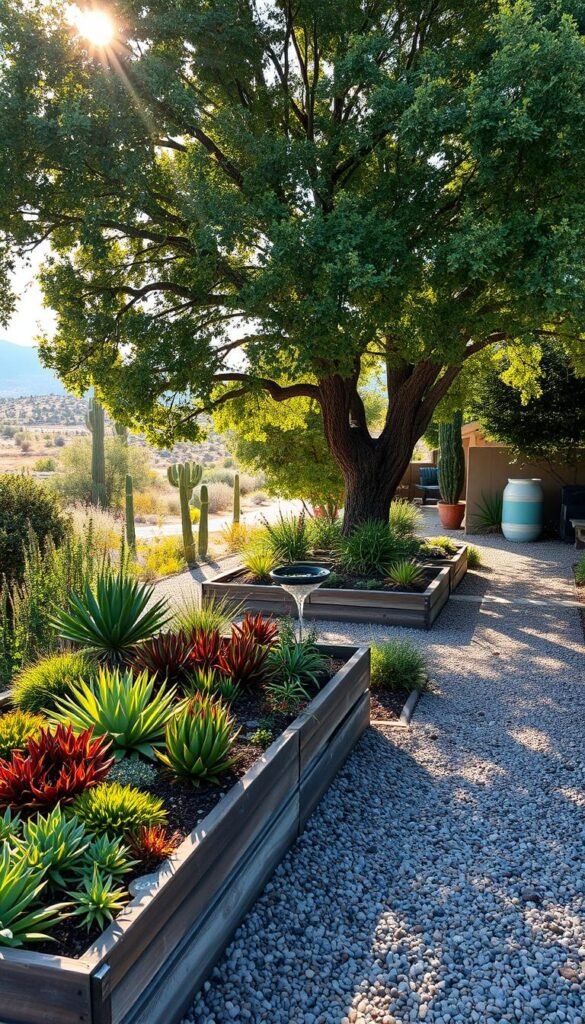
Smart gardeners know that working with nature’s rhythms unlocks hidden potential. Pairing regional species with smart water management creates landscapes that practically care for themselves. Let’s explore how simple shifts in approach can transform your yard into a self-sustaining oasis.
Harvest Every Drop
Rain barrels capture runoff from rooftops, storing free water resources for dry spells. Connect them to drip irrigation systems that deliver moisture straight to roots. Soaker hoses work wonders too – they reduce evaporation by up to 70% compared to sprinklers.
| Method | Water Savings | Setup Cost |
|---|---|---|
| Rain Barrel | 1,300 gal/year | $60-$120 |
| Drip Irrigation | 50% less usage | $0.50-$2/ft |
| Bioswales | 30% runoff reduction | $10-$15/sq ft |
Feed the Earth, Protect Your Ground
Spread 3 inches of wood chips or shredded bark around plants. This living blanket keeps soil cool, smothers weeds, and breaks down into nutrients. For slopes prone to soil erosion, plant deep-rooted natives like switchgrass – their roots grow 10 feet deep, anchoring earth naturally.
Group species by water needs for smarter care. Drought-tolerant yuccas thrive in sunny zones, while fern varieties cluster in shaded, moist areas. Your gardening routine becomes simpler when each plant grows where nature intended.
These strategies work together like pieces of a puzzle. You’ll conserve resources while building healthier soil systems that support thriving ecosystems season after season.
Integrating Hardscaping with Natural, Eco-Friendly Materials
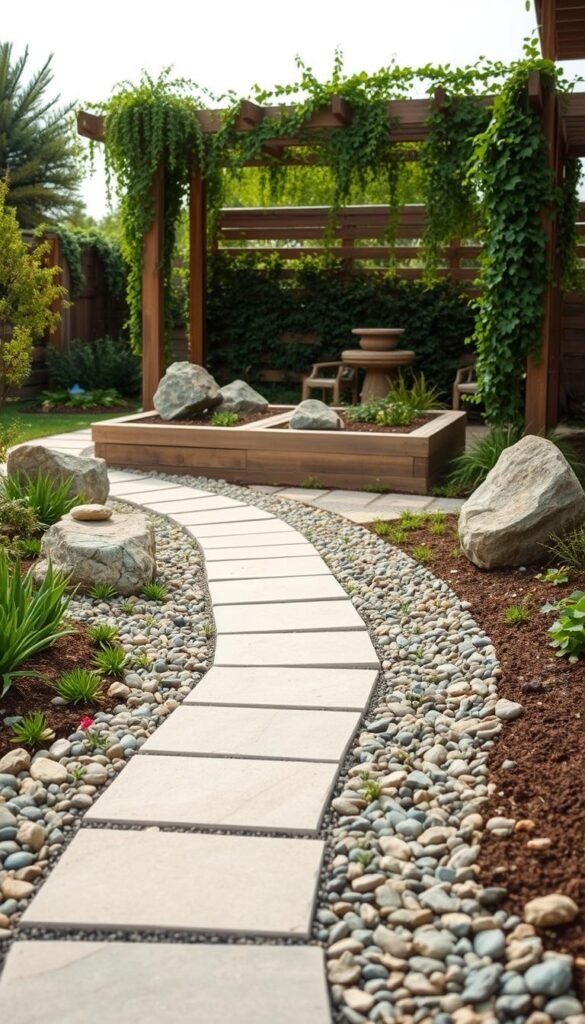
Your garden’s pathways can do more than guide footsteps—they can nurture the earth beneath them. By choosing permeable materials, you create surfaces that work with nature’s water cycle while adding structure to your space. This approach blends practicality with environmental care, turning every stone and paver into an ecological asset.
Smart Surfaces That Breathe
Traditional concrete slabs repel rainwater, worsening runoff and soil erosion. Permeable alternatives like crushed granite or interlocking pavers let moisture seep through, feeding plant roots below. These options prevent puddling and reduce strain on stormwater systems during heavy rains.
| Material | Water Infiltration | Cost Per Sq Ft |
|---|---|---|
| Gravel | High | $1.50-$4 |
| Permeable Pavers | Moderate-High | $8-$15 |
| Stepping Stones | Medium | $3-$8 |
For structures like raised beds, opt for untreated cedar or recycled composite lumber. These materials resist rot without chemical treatments, keeping toxins away from your plants. Curved pathways made from local flagstone add visual flow while minimizing excavation damage.
Position hardscapes to create microclimates—a sun-baked stone wall shelters heat-loving herbs, while shaded gravel areas cool moisture-sensitive succulents. As landscape architect Julie Moir Messervy notes:
“The best designs solve two problems at once—beauty and function rooted in ecological intelligence.”
Source supplies from regional quarries or demolition sites to reduce transportation emissions. Repurposed bricks or salvaged slate often carry unique character while costing less than new materials. Your garden gains charm as it champions sustainability.
Creating a Wildlife-Friendly Environment in Your Garden
Your outdoor space can become a bustling hub for nature’s most helpful allies. By focusing on regionally adapted species, you’ll build a living pantry that feeds birds, shelters pollinators, and strengthens local ecosystems. Let’s explore how simple plant choices can turn your yard into a thriving refuge.
Nature’s Grocery Store in Your Backyard
Serviceberry trees offer three seasons of value—spring blossoms for bees, summer berries for birds, and fall color for your enjoyment. Purple coneflowers act as landing pads for butterflies, while their seed heads become winter snacks for finches. These hardy varieties require little care but deliver maximum impact.
Consider adding flowering dogwoods or eastern redbuds. Their branches provide nesting spots, and their flowers support over 50 types of pollinators. For a powerhouse habitat plant, native oaks host nearly 500 insect species—critical food for chickadees and warblers. Even a small cluster of willows can shelter beneficial creatures while stabilizing soil.
Remember: Diversity is key. Mix tall trees with berry-producing shrubs and ground-level bloomers. This layered approach mimics natural forests, giving wildlife everything from shelter to snacks. Your garden becomes not just beautiful, but essential to your neighborhood’s ecological web.

